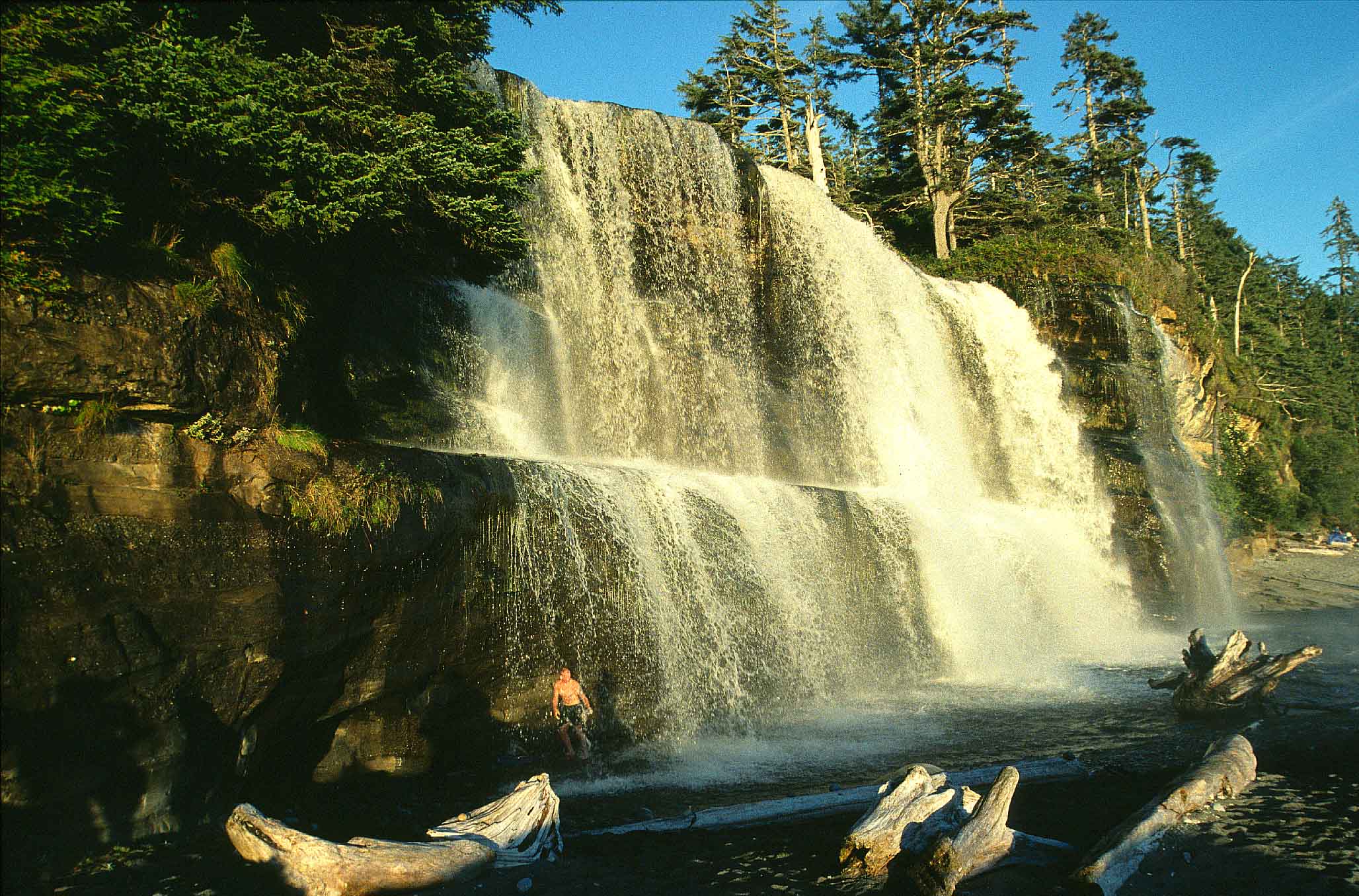
Tsusiat Falls, West Coast Trail
Pacific Rim National Park, British Columbia

Fine Art Photographic Printing vs. Mass Produced Poster Printing
Traditionally posters may include photographs, graphic art images, and
text as opposed to a print of just a single photograph . Posters are also
normally mass produced with offset printing machines resulting in fairly good
quality at a low price. Unfortunately this printing technique sacrifices high
image quality for low price. Offset printing cannot show the rich saturated
color range of a custom printed color photograph, nor can it support the high
resolution images that quality cameras, whether film or digital, can produce
today.
My archival photographs are all printed at specialty fine art photography print
labs
with printers that use pigment based inks which are inherently UV resistant.
With these printers you get not only rich color saturation and high image
resolution but archival print life. Archival print life is on the order of 70+
years with negligible fading when framed under at least regular glass or
Plexiglas and not exposed to direct sunlight. Using UV resistant glass or spray
would extend this life. Examples of these pigment based printers include:
Durst Lambda, Chromira, Epson 9800/9600, or HP DesignJet 5500. These printers are the state of
the art in Fine Art Photographic Printing and were designed primarily for that
purpose. The printer I'm using exclusively for archival prints is the Durst
Lambda whose prints have an estimated 100+ year archival life. This is a
phenomenal printer, but at $500,000 it should be. No I do not own one! By comparison conventional Cibachrome
photography printing has a life on the order of 30 years. The specifications of
these printers equal or exceed the specifications of the HP DesignJet 800 PS
printer listed below.
The HP DesignJet 800 PS printer that I have, while very high quality in
terms of color saturation and resolution, uses dye based inks which are not inherently
UV resistant and therefore not archival. You are getting a custom printed
photograph with all of the advantages that entails but the image will most
likely start to fade in a couple of years. My posters are normally printed with
this printer and their price reflects that. If requested they can be printed on
an archival printer. Image permanence of several years is normal for any
non-archival printer. This printer supports 42" x 100' rolls of high quality
print media in a variety of formats and prints at resolutions of 1200 to 2400dpi
in true color, which is 16.7 million colors. Covering these images with UV
resistant glass or spray will extend their life - do not expose them to direct
sunlight. Even archival photographs should not be exposed to direct sunlight.
This specific printer is more versatile than the previously mentioned printers
in that it does a very good job on any type of printing including: engineering
drawings, solid model renderings, maps of any kind, graphic art posters, and
photographs.
Print permanence is affected by: Incident light, pollutants in the air - notably ozone, relative humidity,
moisture, finger prints, and using non archival paper and mounting techniques. Wilhelm Image Research is the
independent research laboratory that evaluates specific printer + ink + paper
combinations primarily for light fastness. Obviously these are accelerated life
tests, none of these printers, inks, or papers have been in existence this long.
Their website is:
wilhelm-research.com
Web Images vs. Printed Photographs and Posters
The web images are shown at much smaller sizes and much lower resolutions than
the actual printed photograph or poster to minimize download times to your web
browser as well as fitting the image on your computer screen. The
web images are typically 72-100dpi, all printed images are
at a much higher resolution. All photographs and posters are printed on heavy, high
quality
photographic paper. The
colors of these web images are somewhat muted compared to the richer and more vibrant
printed artwork. Typical artwork file sizes range from 20 Mb for a single 8x12
photograph to 300 Mb for the larger photographs and up to 500 Mb for the
topographic map posters. Each
website image includes a large visible copyright notice to
protect the photographer's intellectual property. The printed photograph or
poster that will be shipped does not include this large copyright notice.
These photographs and posters are copyrighted material and are protected by United States and
International copyright laws. A very small copyright notice appears at the bottom of
each printed photograph or poster and covers that piece and all contained photographs.
All of these photographs or posters are printed on demand, one at a time.
They are large custom printed photographs printed on high quality photographic
paper and not conventional mass produced offset
printed posters. This has the advantage of not only providing much higher
quality images but also allowing a large number of different photographs or posters to be available. The
disadvantage is the higher cost per print compared to traditional offset
printing. By printing on demand I'm
limited only by time and creativity and it allows creating and printing different
versions of the same poster with different text or colors. One version emphasizing the
backpacking trail or scuba diving area, while another version uses text that
evokes a more emotional response that would be independent of any specific
geographic area but is linked only to the image itself.
For those who are wondering why the smallest photograph size isn't 8x10 you should
know that 8x12 is the standard size that matches 35mm film. All 8x10's are 2
inch crops. Poster sizes are shown in the filename. For example
Paria-20x36-PariaCanyon-1A.jpg
refers to a Paria Canyon poster that is 20" wide by
36" tall, its name also happens to be PariaCanyon and it is version 1A, the file
type is JPEG for fast downloads to your browser.
![]()